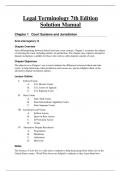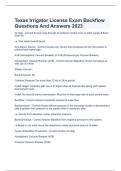Legal Terminology 7th Edition Solution Manual Chapter 1 Court Systems and Jurisdiction Ante Interrogatory: D Chapter Overview After differentiating between federal and state court systems, Chapter 1 examines the subject of selecting the court, including matters of jurisdiction. The chapter also explores alternative dispute resolutions available for those who wish to settle disputes outside of court. Chapter Objectives The objectives in Chapter 1 are to teach students the difference between federal and state courts, to help them learn what jurisd iction and venues are, and to enlighten them on the alternative dispute resolution options. Lecture Outline I. Federal Courts A. U.S. District Courts B. U.S. Courts of Appeals C. U.S. Supreme Court II. State Courts A. State Trial Courts B. State Intermedi ate Appellate Courts C. State Supreme Courts III. Jurisdiction and Venue A. In Rem Action B. Quasi in Rem Action C. In Personam Action D. Venue IV. Alternative Dispute Resolution A. Negotiation B. Mediation C. Arbitration D. Mini -trial Notes The Sources of Law box is a side note to students to help them grasp from where law in the United States comes. Word Wise boxes are helpful to students as they learn about how words are used in several ways, such as the word “court” in this chapter. The other Word Wise box, addressing the definition “to speak,” can help students’ minds connect with words they are already familiar with in learning new terms. Prefixes and suffixes often indicate a Latin root word, and as students recognize them, they can r emember new term definitions easier. List of Changes The chapter opens with “Learning Objectives” section “Chapter Outline” section has been eliminated Pronunciation tips of Key Terms have been eliminated “Websites for Pronunciation Help” section with li nks to two websites has been added. The term ordinance has been added to Key Terms and the Glossary. Updates on the creation of administrative codes in “Sources of Law” section Updates on federal appellate courts in “U.S. Appellate Courts” section Two Ter ms in Action boxes are in every chapter to illustrate how terms are used in real-life situations. Some are current, quirky stories including celebrities, and others are interesting historical cases with surprise endings that will help students remember the terms in the chapters. In Chapter 1, the Terms in Action educate the student about courts, jurisdiction and venues. In the first Terms in Action box the story about Laci Peterson, which the story addresses the occurrence of change in venue,. has been rep laced with the story about Dzhokhar Tsarnov. Unraveling Legalese is not in the textbook, but is found below for the instructor to give to students as another exercise. Corrections To Be Made for Chapter 1 1. The glossary definition of cert. den. should also include: When the U.S. Supreme Court decides not to hear an appeal, the Court denies issuing the writ of certiorari by writing the abbreviation “ cert. den. ” on the court record. Also to refer to writ of certiorari for further definition. 2. Change of venue in the glossary should be added with the definition: the removal of a suit begun in one county or district and the replacement of it to another county or district for trial. 3. Diversity of citizenship in glossary should have a replacement definition: a term used to describe cases between persons from different states, between citizens of the United States and a foreign government, and between citizens of the United States and citizens of a foreign country. 4. The in personam action definiti on in glossary is updated to read: (personal action) A lawsuit in which the court has jurisdiction over not only the subject matter, but also the parties involved in the case. Reviewing What You Learned 1. Federal courts hear cases that raise a federal que stion (a matter that involves the U.S. Constitution, acts of Congress, or treason). Federal courts also decide diversity cases (exceeding the sum of $75,000) that involve diversity of citizenship (over $75,000) between persons from different states, betwee n citizens of the United States and a foreign government, and between citizens of the United States and citizens of a foreign country. In addition, federal courts hear bankruptcy cases, patent and copyright cases, and admiralty cases. 2. Appeals may be ma de from a state supreme court to the U.S. Supreme Court only when a federal or U.S. constitutional question is raised. 3. U.S. courts of appeals decide cases that have been appealed from federal district courts. The only exception is the Federal Circuit Co urt of Appeals which hears appeals on its specialized subject (e.g., patent cases) nationwide. 4. For a court to have jurisdiction over an in rem action, the property must be located in the state (and usually the county) where the court sits. 5. If a defe ndant owns real property in one state and lives in another, the court where the real property is located has jurisdiction in an in rem action. 6. In question 5, if suit is brought against the defendant in the state where the property is located and the out -of-state defendant does not appear, the plaintiff's recovery will be limited to an amount up to the value of the property located in that state. 7. To bring a lawsuit against a person and hold him or her personally liable, a personal action, called an in personam action, must be brought by the plaintiff. 8. If the plaintiff's attorney begins an action in a court of improper venue, the defendant's attorney may have the case transferred to a proper venue. The defendant’s attorney may also have the case dismi ssed by filing a motion or by raising that issue in the defendant’s answer. 9. Jurisdiction relates to the power of the court to hear a case; whereas venue relates to the geographic location where the action should be tried. 10. Mediation has a neutral thi rd party (mediator or conciliator) who listens to both sides and makes suggestions for reaching a solution. The mediator tries to persuade the parties to compromise and settle their differences. A mediator is not empowered to make parties settle, but he or she has authority over the mediation process. Arbitration has a neutral third party (arbitrator) who makes a decision after hearing the arguments of both sides. Parties have already agreed to resolve their dispute according to a pre -determined arbitr ation process. Parties can agree to binding arbitration (arbitrator’s decision will be final) or nonbinding arbitration (arbitrator’s decision is simply recommended with no need to comply with it). 11. Negotiation is a two -party process in which no n eutra l third party is involved. The sides attempt to conclude their dispute by bargaining with each other until one side agrees to the oth er side’s offer of settlement. Parties in legal dispute may have legal representa tion, but it is not necessary. A written a greement (a contract) settles the dispute, and settlement terms are often kept private. 12. Mediation is an informal process in which a neutral third party (mediator or conciliator) listens to both sides and makes suggestions for reaching a solution. Medi ation takes place in stages and breaks into private sessions called caucuses. The mediator uses his or her listening skills and the ability to ask probing questions to learn what the interests are behind each side’s demands. From that point on the mediato r seeks small gains from each side as he or she works to bring disputing parties together, so a mutually acceptable agreement (the settlement) can be reached. The mediator is not empowered to make the parties settle, but he or she has the authority over t he mediation process. 13. The parties in an arbitration process agree to binding arbitration in advance. The decision of the arbitrator (or arbitration panel) will be final and must be followed. The arbitrator’s decision must be in writing. The arbitrator ’s decision is called the arbitrator’s award regardless whether the arbitrator rules in favor of the plaintiff or the defendant. One of the serious consequences of binding arbitration is that it is nearly impossible to appeal the arbitrator’s decision. Understanding Legal Concepts 1. T 6. F, property 2. F, four 7. T 3. T 8. F, property, person 4. T 9. T 5. F, sometimes 10. T Checking Terminology (Part A) 1. h 5. s 9. m 13. z 17. c 2. v 6. n 10. a, t 14. k 18. b, j 3. q 7. x 11. g 15. l 19. d 4. o 8. y 12. r 16. p 20. e 21. w Checking Terminology (Part B) 1. h, n 5. l 9. a 13. g 17. j, p 2. e 6. t 10. c 14. v 18. r 3. i, o 7. m 11. d 15. b 19. k 4. f 8. q 12. s 16. u Unraveling Legalese Use simple, non -legal language, with the help of the glossary, to rewrite this quote in the space below so that it is shorter and can be understood by a layperson without losing its meaning. Exercise: The Appellants argue that Congress’s use of the permissive “may” instead of obligatory “must” demonstra tes an intention to sustain concurrent jurisdiction. While it is true that some courts have found concurrent jurisdiction because of the use of the permissive “may,” the statues at issue in such cases did not contain the more potent language contained in this statute: “original exclusive jurisdiction.” That difference makes the analysis in those cases inapplicable. Answer: The party that appealed argued that Congress’s use of “may” instead of “must” in the law shows that it meant to allow two or more cour ts to decide the case. Although some courts have decided cases following that argument, those cases did not have the stronger statutory language with the words “original exclusive jurisdiction,” which means that only one particular court has the power to h ear the case when it is first brought to trial. Using Legal Language To settle a dispute by means other than litigation over who owned the lot next to her, Susan tried to get Conrad to participate in a(n) alternative dispute resolution. Conrad wanted to use negotiation because he didn’t want anyone else involved. Susan wanted to use mediation






